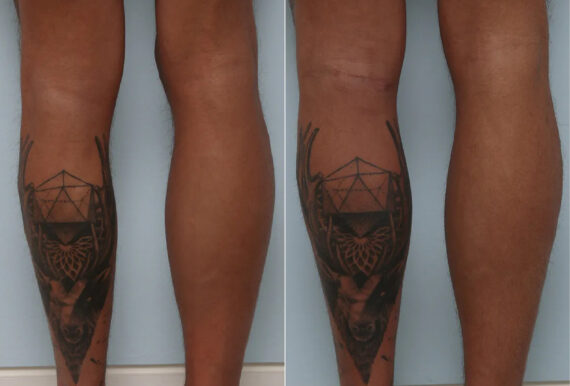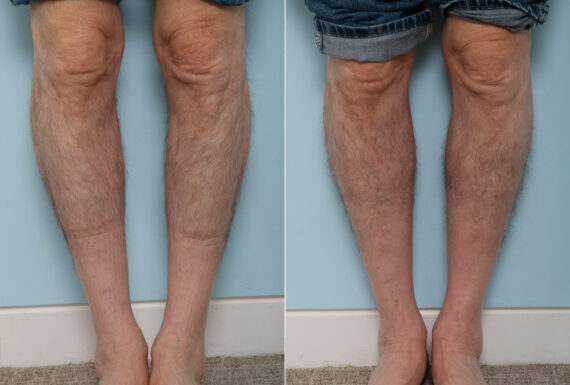Male calf implant surgery is gaining popularity among men who want to enhance the shape and size of their calves. This surgery can dramatically improve how the legs look, making them seem more proportional or muscular, depending on what the person wants.
Dr. Paul Vitenas has extensive experience performing cosmetic surgeries, including calf implants for men. Patients consulting Dr. Vitenas for this procedure can count on getting professional advice and quality care. He ensures patients understand the surgery, experience a safe process, and get the best results from their calf implants.

Boosting Leg Aesthetics with Calf Implants
- Male calf implants are cosmetic procedures that enhance the shape and size of the calves for a more muscular appearance.
- Calf implant surgery is tailored to individual needs and can address muscular imbalance or naturally skinny legs.
- The procedure involves placing silicone implants in the calves and requires downtime for recovery.
- Risks associated with calf implants include infection, implant displacement, and dissatisfaction with cosmetic results.
- Researching experienced surgeons and understanding the procedure’s limitations are important steps before undergoing calf implantation.
Understanding Male Calf Implants: Purpose and Popularity
Men choose calf implants for various reasons. Some aim to increase body size for endeavors such as bodybuilding, while others have hypoplastic calves that appear underdeveloped. When building calf muscle through exercise isn’t sufficient, calf implants offer a viable option for those looking to improve their lower body symmetry. Achieving balance through these implants can contribute to higher self-confidence.
Calf augmentation is becoming more common as men focus more on their looks. Using silicone calf implants, individuals can customize the shape of their legs, resulting in a tailored and natural appearance. Silicone calf implants are designed to match the unique contour of a person’s calves, enhancing the overall body framework.
Exercise is an alternative to calf implants for those who prefer a non-surgical route. Yet, the average results from calf augmentation typically exceed outcomes from exercise alone, so calf implants are a favored choice for noticeable and durable lower leg enhancement.
Types of Calf Implants for Men
Men can enhance their leg shape with two types of calf implants: silicone calf implants and fat transfer augmentation.
Silicone calf implants are crafted from a soft, durable material that feels similar to muscle. The procedure involves placing these solid calf implants through a small incision to improve calf size and shape.
For a more natural look, grafting for calf augmentation uses the patient’s fat. Fat grafting requires fat removal from one part of the body, followed by injection into the calves, offering the added advantage of slimming the donor site. Proper technique is essential to achieve a balanced and natural result.
For the best outcomes, both methods, calf prostheses and fat grafting, should be performed by skilled professionals.
The Ideal Candidate for Male Calf Implants
An ideal candidate for calf implants is a well-informed patient with clear aesthetic goals to improve leg shape. The procedure suits those looking to correct imbalances from genetics or health conditions, aiming for a well-proportioned, muscular look.
A good calf implant candidate maintains health and a consistent weight for safety and effective results. Understanding the procedure and its realistic outcomes is essential for aligning expectations with the enhancements calf augmentation can offer.
Preparing for Calf Implant Surgery: A Pre-Op Checklist
Patients approaching calf implant surgery must take certain steps to prepare. This checklist ensures you’re ready:
- Consult with your surgeon: Discuss your medical background and surgery expectations during your initial consultation.
- Medication review: Inform Dr. Vitenas about all medications, as adjustments may be necessary.
- Arrange for recovery: Secure a ride home after surgery and help during recovery, if necessary.
- Pre-surgical tests: Fulfill all pre-surgery evaluations and bloodwork your surgeon requires.
Adequate preparation is essential for calf implant surgery success. Engage with your surgeon in consultation to understand the process and set the stage for a positive experience.
The Calf Implant Procedure: What to Expect During Surgery
Undergoing a calf implant procedure is generally straightforward for the patient during surgery. The surgeon will make an initial incision behind the knee to reduce scarring visibility. They will then prepare the incision sites for the implants.
Here’s an overview of the process:
- The surgeon creates a pocket within the muscle
- The implant is carefully inserted
- The implant is secured in place
Stab incisions facilitate a minimally invasive method that aids in shorter recovery times. Surgeons close the incision sites with precision, concluding the surgical stage.
Recovery and Aftercare: Ensuring the Best Results
Proper recovery is key to success after calf implants. Adhere to the post-surgical care instructions your surgeon provides. This will speed up the healing process and ensure your safety as you return to everyday life.
Postoperative care should include:
- Using medication as needed for discomfort.
- Cleaning incision sites to prevent infections.
- Wearing compression garments to manage swelling.
Calf implant recovery time usually sees a decrease in swelling and bruising within the week after surgery. Stick to the guidelines for a smooth healing process. Dr. Vitenas will tell you when it’s safe to increase physical activities and when to avoid strenuous exercise until the healing process is complete.
Following these postoperative care instructions makes you more likely to see the best results as you recover.
Potential Risks and Complications of Calf Implant Surgery
Calf implant surgery, while typically safe, involves certain risks and possible complications. It’s important for prospective patients to be aware of these before undergoing calf surgery to enhance leg shape or correct leg defects. Key concerns include:
- Complications from calf implant, such as infection, implant movement, or negative reactions to anesthesia.
- The risk of post-operative problems like excessive swelling, bleeding, or blood clots, possibly needing more treatment or operations.
- Chances of noticeable scarring or unevenness if implants don’t match the legs’ natural shape.
- The possibility of not achieving the desired aesthetic, which might leave leg defects partially unaddressed and prompt additional surgeries.
Awareness of these outcomes is vital when considering calf surgery.
The Impact of Calf Implants on Athletic Performance
Calf implants can influence your athletic performance due to changes in calf size and posterior muscles. After getting implants, the muscle performance during calf implant adjustment may vary, especially in sports requiring leg strength. Individuals engaging in regular gym workouts and leg exercises may notice differences in leg muscle engagement. Monitoring these effects to balance aesthetic improvement with physical abilities is important.

Long-Term Care for Your Calf Implants
Keeping your shapely calf region in prime condition requires regular attention. To preserve the results of your calf implants and maintain well-developed calf muscles, these steps should become part of your routine in the months after calf implant surgery:
- Introduce light exercises, progressively including strength training for the entire body. This helps keep the calf’s appearance balanced.
- Adopt a skincare routine to keep the skin around the implants supple and healthy, enhancing the look of your calves.
- Regularly visit your surgeon for implant check-ups to catch any issues early.
Proper care for your implants is integral to your overall body wellness and critical for lasting results.
Choosing the Right Surgeon for Calf Implant Surgery
Looking for a surgeon for your calf implant surgery is key to ensuring a successful outcome. To find a board-certified plastic surgeon tailored to your needs, consider the following:
- Board Certification: Choose a board-certified plastic surgeon who has comprehensive training and maintains high standards.
- Experience: Select a surgeon with specialized experience in calf enlargement, as this can lead to better aesthetic results.
- Patient Outcomes: Opt for an acclaimed plastic surgeon with a portfolio showing a range of successful procedures for each individual patient.
- Safety: A surgeon known for safety reasons with a track record of handling complications effectively is crucial.
- Patient Testimonials: Look for feedback from previous patients, including club foot patients, to gauge satisfaction with the surgeon’s work.
Finding a surgeon who matches these criteria will enhance the likelihood of a positive experience for the average patient seeking calf implants.
Key Takeaways in Selecting Calf Implants
Calf implants are not only for aesthetics but can address bilateral calf deformities and support a proportional body. Assessing your cosmetic goals is crucial when considering this option.
For those with minimal calf muscle definition or a plateau in calf development despite exercise, calf implants can complement the upper body for a consistent look, notably for bodybuilders or individuals into body implant plastic surgery.
Cost variance is tied to the complexity of calf implant surgery. Reviewing photos of patients after specialized calf implant surgeries helps set realistic expectations for your calf shape post-surgery.
Developing calf muscles is essential; calf augmentation should blend naturally with your muscles. A surgeon experienced in surgical calf augmentation procedures can personalize the surgery for you, considering your medical history and the presence of congenital defects.
Consider these factors:
- Assess how calf implants align with your fitness and aesthetic goals.
- Look into calf implant sizes suitable for your entire body.
- Be aware of the cost and what it entails.
- Analyze patient photos post-surgery for real-life examples.
- Consult with a surgeon to discuss suitability and congenital defect correction.
With these considerations, you can decide if calf implants meet your needs.
Are you considering male calf implants to improve the shape of your legs? It’s important to make an informed decision. For expert guidance, a consultation with Dr. Paul Vitenas is advisable. With decades of experience as a board-certified plastic surgeon, Dr. Vitenas has a history of satisfying patients with attentive, personalized care and excellent aesthetic outcomes.
If you’re contemplating calf implants and desire reliable results, contact Vitenas Cosmetic Surgery. As a dedicated practitioner in Houston, Dr. Vitenas ensures that every treatment plan meets his patients’ unique needs and expectations. Schedule your consultation today to take the next step toward your aesthetic goals with confidence.


